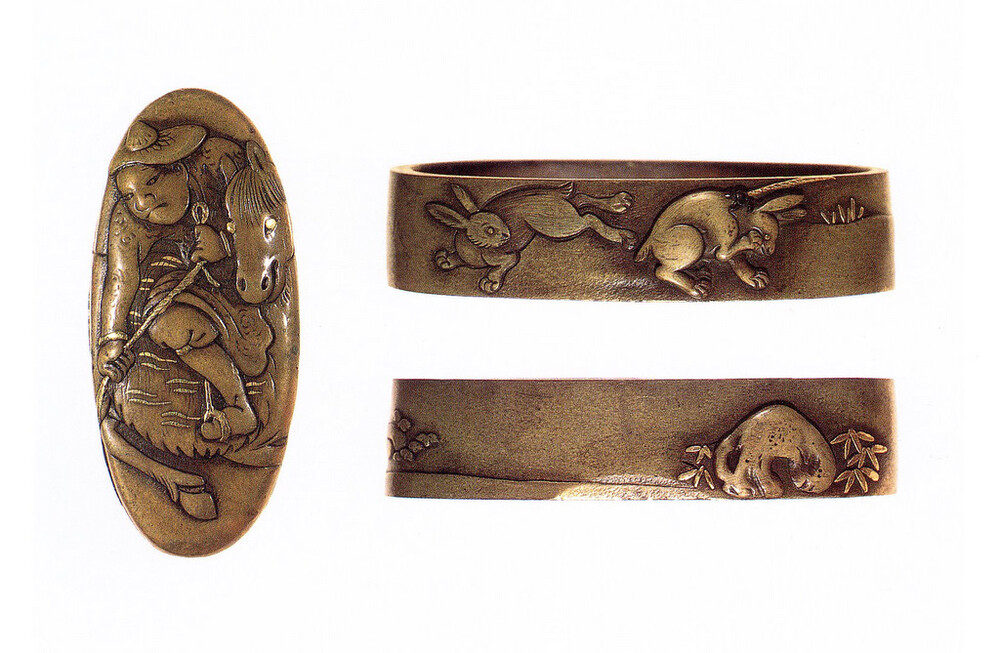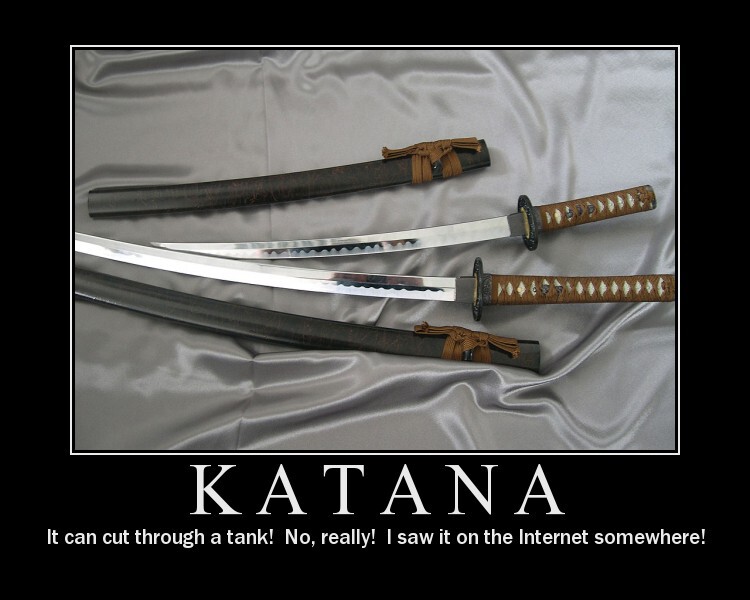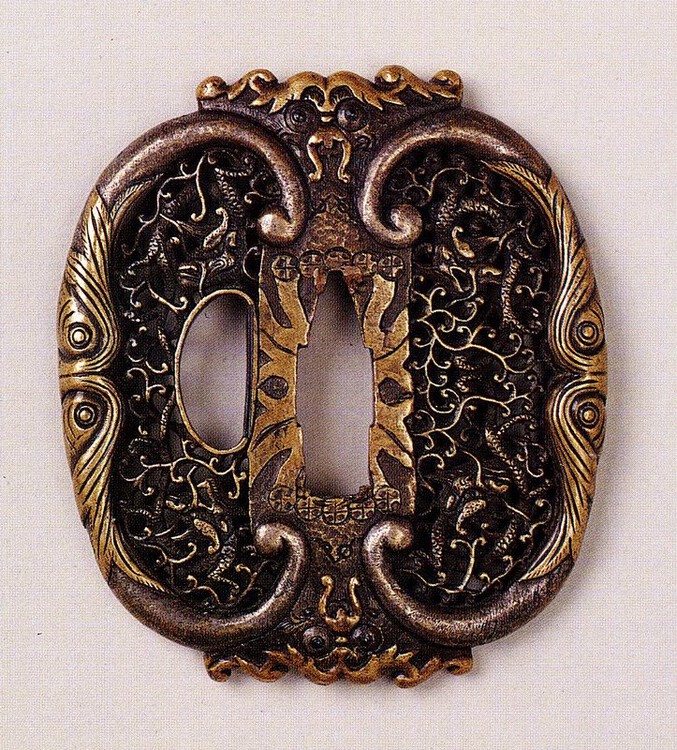-
Posts
3,091 -
Joined
-
Days Won
78
Content Type
Profiles
Forums
Events
Store
Downloads
Gallery
Everything posted by Ford Hallam
-
Hi Dr John, here are some images of accepted work by this artist. These used to be in the fittings museum in Tokyo and were part of an exhibition they had of the Nara San-saku.
-

New Sword Association in town
Ford Hallam replied to Ford Hallam's topic in General Nihonto Related Discussion
oooh...you just wait Sinclair, I know where you live Kettle, pot...black? still waiting for my stipend. -
many of you will no doubt be aware of rumours about a proposed new sword culture promotion association. Well, it seems it's a reality. . Pierre Nadeau just sent me a link to an article that explains all. You'll find all the details here; on Pierre's website. ...and for our French members here is the original article from the website of Franz Baldauff. ...and the official Japanese web-site. Personally I quite like the title; Tōbunkyō 刀文協...Sword Culture Association regards, Ford
-
Ian, of course! you're absolutely correct about the pre Edo period mounts often being depicted with a guard of some sort. In fact, I was just browsing your own book on Samurai Arms and Armour for a suitable image to post...but they're all a bit small , the images, I mean But my question remains, any guard that was made specifically for a naginata would have had a nakago ana essentially indistinguishable from that of a regular sword. So why are these tsuba with rectangular openings assumed to be Naginata tsuba?
-
I may have missed something, in which case I'm sure I'll be "corrected" quickly but...what is the rationale that these guards are for Naginata or Nagamaki? If it's the fact that the nakago-ana is rectangular I'd counter by saying that both those types of blade have essentially the same cross-section of the nakago as do regular sword blades. I have seen the sort of guard that is essentially an over sized washer, almost a tanto tsuba, but they have always had recognizable sword shaped nakago-ana; like this example here. Just wondering where this idea comes from because I've never seen either of these sorts of pole arms mounted with regular sword type tsuba...but I haven't seen loads anyway so maybe I have missed something Ford
-
yamagane; literally; mountain metal, generally refers to unrefined copper and is typically anywhere from a chocolate brown to almost black in colour when patinated.
-

Casting moulds for menuki and tsuba
Ford Hallam replied to DirkO's topic in Auctions and Online Sales or Sellers
Now that is cheeky ...btw; these are the rubber mould that are used to create the wax model that is then used in the mould. -
Ted, nah...I think we're on the same bit of the fence...hope it can take our weight I agree that when we finally get more comprehensive and broader ranging sample collections of the mei an artist used over the course of their career we'll have to take the artistry workmanship into account a lot more. This is the area of study that interests me most, the technical and artistic development and expressions of these amazing artists. I agree also that it ought to be about the work but....people want to collect names. I suppose we all want to feel we're holding something that bears the touch of a master. I'd add though, that the work should be self evidently worthy of a master to be worthy of that reverence.
-
Ted, I liked your post but....with regard to consistency of mei on tosogu this does pre suppose an intention on the part of the maker to sustain said consistency. I can show numerous examples of significant evolution within given artists work that might, with fewer examples be dismissed as gimei because they fall outside the accepted canon. Herein lies the problem, we simply don't have, in most cases, enough samples to judge a lifetimes output on . It might be of interest to consider the words of the late "National Living Treasure" potter; Shoji Hamada, when asked why he didn't sign his work. He replied that his bad work would be ascribed to his students while their best work ( similarly unsigned out of respect to their teacher) would be credited to himself.
-
Not being one to shy away from poking hornets nests myself I'll jump in with the following additional observations. For starters I think we need to look at the sword mei and tosogu mei as separate issues. My reasoning is as follows; With sword mei I think there is a far greater range of samples to gain an accurate impression of a given makers style of mei as a result of long tradition of making oshigata. The situation with regard to tosogu is nowhere near as comprehensive and as oshigata are rarely made of mei on tosogu we are reliant on photographs. The problem with photo's, especially many of the older ones, is that they are so indistinct at times as to give very different impressions based on the angle of the lighting. Obviously this is not a problem on oshigata. The second point I'd like to make is with regard to the different technique employed in making the mei in each case. With swords (and a few, earlier steel guards) the characters are struck, directly into the metal, with a tapered wedged shaped punch giving the characteristic arrow-head marks. With most mei on tosogu the kanji are actually cut, most frequently with a kata-kiri chisel which gives the distinctive brush stroke-like effect. Of the 2 methods it is very obvious to me that the mei on tosogu are far more likely to exhibit subtle variations due to the differences in material composition ( copper as opposed to steel or shibuichi...for instance) as well as the sort of changes in stroke formation that are commonplace in normal calligraphy with a brush. I think that the over reliance on the "spot the difference" approach to mei validation has come about precisely because of the lack of really well illustrated catalogues of genuine work showing workmanship and artistry, particularly with regard to tosogu.
-
I wonder, Peter, do you have any evidence for your assertion?...or is this really just your impression? I'd be very interested to see how this tsuba actually fits on the wakizashi it came on. Any chance of some images of it on the nakago behind the habaki but without the tsuka in place? The first thing that strikes me is the oversized nakago-ana, the edge of the blade would seem to be off the seppa-dai. It's also very uncharacteristically angular, frequently a sign of modern workmanship. The need to file the nakago-ana up like this is most probably to obliterate the tall-tale seam lines of lost wax casting. The overall graininess and loss of definition further confirms this as a modern cast copy to my eyes.
-
If it's traditionally made material, ie; charcoal fired tatara, then it would be practically impossible to produce a ferrous product that didn't contain some carbon ,thus making it steel. The average carbon content of the outer skin of a sword is 0.7%....just as an indication of how little carbon is required to make a decent steel. The use of the term "iron" with regard to tsuba, while a convention we've grown used to, is, technically speaking, completely misleading. ...and I think I deserve an award there for the most commas per actual words.
-
If this tsuba is steel, and I believe it is, then this is quite a rare piece. Nanako ( that surface decoration of tiny grains) is extremely rare on steel because its so very hard to do without repeatedly ruining your punches. If you look closely, with magnification, at the edge where the traces of gold are, you may see fine cross hatching that would indicated that the gold was applied by way of nunome-zogan. regards, Ford
-
...but take care to avoid those pieces he cast...easily recognisable by the "made in Japan" stamp inside the nakago ana.
-
Hi Markus, that some great info there. I was vaguely aware of the appeal things antique about that time but didn't know any of the specifics regarding Reisho. Thanks also for the translation of the poem, and Koichi's additional material. regards, Ford
-
Hi Colin, Kano Natsuo (1828-1898) is considered my many connoisseurs to be one of the, if not the, finest artists in the kinko tradition. He seems to have been a good businessman and ran a very productive studio. Many of his assistants/students went on to become celebrated Meiji period artists in their own rights. Natsuo was appointed "Teishitsugigeiin" to the Emperor's court, this was the sort of position that would eventually be better known as "Ningen Kokuho", the holder of an Important Intangible Cultural Asset. His workmanship, from a technical point of view, is always flawless and incredibly sensitive and delicate. He had a very refined, elegant and understated aesthetic which for many epitomises the highly cultured court life of the Heian period. I've seen a few kozuka by him but I suppose they are a bit of a rarity. The inscription is in a clerical script that evokes a strong antique feeling, and would have done so even when it was new. I'd suggest that the quality of the piece lies as much with the actual carving of the kanji as with the calligraphy. What I mean is, this would be a fine piece of calligraphy even if it was "merely" painted on paper....all the more impressive that it's carved, so perfectly, in steel. It's very easy to overlook much of the real beauty of work like this, particularly when only viewing a photo, but there is a great deal more here than first meets the eye. It's this sort of subtle and sophisticated chisel work, almost regarded in an abstract way, that is most highly prized by the Japanese connoisseur, whereas in the West the most commonly appreciated aspect is the subject matter. Hope that sheds a little light on the matter, regards, Ford p.s. If you'd like to study another genuine example here's one of his classic tsuba with carp. Once you run your cursor over the downloaded image you'll get a much bigger image to see. It's worth looking closely at the rim. Note how sensitively he has worked it and how organic and natural it seems...it defies the actual material in a way.
-

Pawn Shop Find having hard time translating
Ford Hallam replied to Avolow's topic in Translation Assistance
Oh!...silly me, I misread the title of the thread....I see it actually says Pawn...must read more carefully in future....still, seems someone was saved from getting screwed :? ...sorry, couldn't help myself. It's late Friday afternoon -
those are brilliant Images, Alan, thanks I'd love to see how a namban tsuba with such a slot would actually fit on a rapier now....interesting.
-
Hi Piers, Now I'm the astonished one, you mean to say he didn't know who I was ...poor man I hope you enlightened him The reason I wanted to exclude that "hidden cross" option was precisely because everyone ( well, some people :D ) posit that explanation. I am not all that convinced. A cross is such a common thing in all sorts of situations that we could find evidence of hidden Christians almost every where :D . I was hoping that perhaps we might uncover some more tangible evidence. A rapier with just such a guard on it might be nice. Perhaps someone would be able to see if such an opening does in fact correspond in any general way to the tang of a rapier etc.
-
Hi Mark, I'd say you're absolutely right but as I'm no longer commenting on these modern cast steel look-a-likes I can't really say.
-
Hi Ian, the copper alloy tsuba is in my opinion, a variety of sentoku. Sort of intermediate brass~bronze. I think the inclusion of the VOC cypher proves a European influence and I believe there has been the suggestion that the "drawer handles" are inspired by European sword hilts of the time. You'd be a far better judge of that though. There's quite a decent collection of 17th cent. VOC arms held at the castle here in Cape Town. The general feeling is of very functional hardware although there are some finer examples and all in very good condition too. I occasionally go for a wander through the old rooms there just to absorb the atmosphere and savour the history and feel of all that aged wood and metal.
-
I just posted this tsuba on another thread re; Namban tsuba. This one clearly shows Europeans, apparently Portuguese or Spaniards. What caught my eye was the square hole that modifies the usual nakago ana shape. This was described as being made so to allow the fitting to a European rapier. I believe Iberian types of Rapier at that time had a square or rectangular cross section tang. Could these mysterious slots have been made to allow the guard to be "multi-cultural" ? To allow them to be mounted on both Nihonto and European swords. A clever way of increasing the tsuba vendors potential market, or a sneaky way to convince native Samurai that these guards were in fact exotic imports.
-
Some great information coming together here just to add to Reinhard's point re; European influence on tsuba here a nice example from the R B Caldwell collection. Note the letters "VOC" that appears on this one as well as the example Reinhard posted. This refers to the "Vrie Oostindische Companie", the Dutch East India Company. It was this company that in fact created the first European settlements here at the Cape, as refuelling stations for ship en route to the east. I still have daydreams of finding some swords of fittings that got left here by some seafarer on his way home from "The Japans"...so far not a sausage though. and this one shows very clear European influence. It's from the Henri D Rosin Collection and the square modification in the nakago ana is described as being made to allow the fitting to a European rapier. This may be what those odd horizontal slots are we occasionally see over nakago ana.
-
Thanks Barry, I reckon Nick's quid was well spent after all then :D regards all, Ford oh, and just to clarify, for anyone not reading all the posts in detail, there's a lot to deal with I know , the casting issue I'm talking about here is only about steel. The casting of bronze type alloys is an entirely different matter. There are many issues in that area that need to be address also, in my opinion, but that will be for another time.










